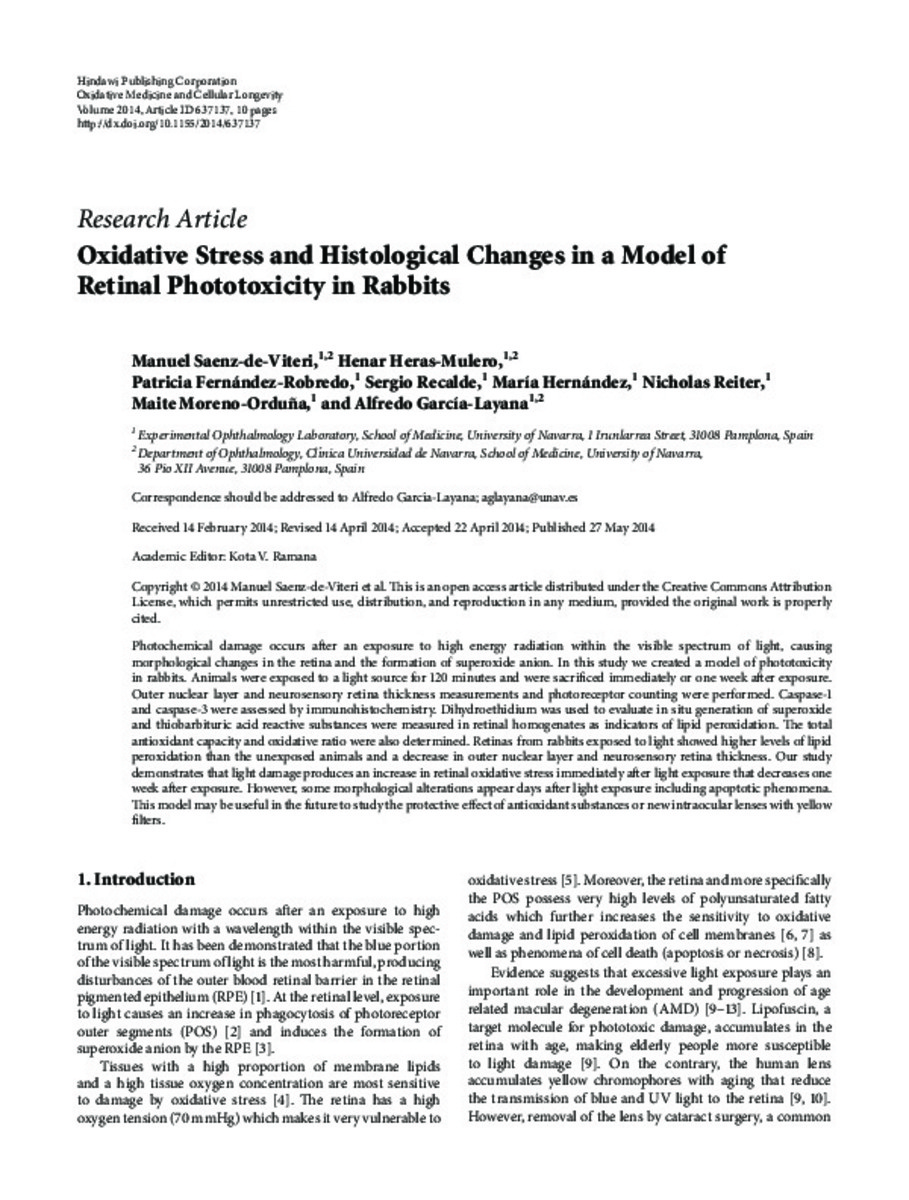Full metadata record
| DC Field | Value | Language |
|---|---|---|
| dc.creator | Saenz-de-Viteri, M. (Manuel) | - |
| dc.creator | Heras-Mulero, H. (Henar) | - |
| dc.creator | Fernandez-Robredo, P. (Patricia) | - |
| dc.creator | Recalde, S. (Sergio) | - |
| dc.creator | Hernandez, M. (María) | - |
| dc.creator | Reiter, N. (Nicholas) | - |
| dc.creator | Moreno-Orduña, M. (Maite) | - |
| dc.creator | Garcia-Layana, A. (Alfredo) | - |
| dc.date.accessioned | 2014-09-15T10:37:58Z | - |
| dc.date.available | 2014-09-15T10:37:58Z | - |
| dc.date.issued | 2014 | - |
| dc.identifier.citation | Saenz-de-Viteri M, Heras-Mulero H, Fernández-Robredo P, Recalde S, Hernández M, Reiter N, et al. Oxidative stress and histological changes in a model of retinal phototoxicity in rabbits. Oxid Med Cell Longev. 2014;2014:637137. | es_ES |
| dc.identifier.issn | 1942-0900 | - |
| dc.identifier.uri | https://hdl.handle.net/10171/36569 | - |
| dc.description.abstract | Photochemical damage occurs after an exposure to high energy radiation within the visible spectrum of light, causing morphological changes in the retina and the formation of superoxide anion. In this study we created a model of phototoxicity in rabbits. Animals were exposed to a light source for 120 minutes and were sacrificed immediately or one week after exposure. Outer nuclear layer and neurosensory retina thickness measurements and photoreceptor counting were performed. Caspase-1 and caspase-3 were assessed by immunohistochemistry. Dihydroethidium was used to evaluate in situ generation of superoxide and thiobarbituric acid reactive substances were measured in retinal homogenates as indicators of lipid peroxidation. The total antioxidant capacity and oxidative ratio were also determined. Retinas from rabbits exposed to light showed higher levels of lipid peroxidation than the unexposed animals and a decrease in outer nuclear layer and neurosensory retina thickness. Our study demonstrates that light damage produces an increase in retinal oxidative stress immediately after light exposure that decreases one week after exposure. However, some morphological alterations appear days after light exposure including apoptotic phenomena. This model may be useful in the future to study the protective effect of antioxidant substances or new intraocular lenses with yellow filters. | es_ES |
| dc.language.iso | eng | es_ES |
| dc.publisher | Hindawi Publishing Corporation | es_ES |
| dc.rights | info:eu-repo/semantics/openAccess | es_ES |
| dc.subject | Retinal phototoxicity | es_ES |
| dc.subject | Uperoxide anion | es_ES |
| dc.subject | Oxidative stress | es_ES |
| dc.subject | Total antioxidant capacity | es_ES |
| dc.subject | Oxidative ratio | es_ES |
| dc.subject | Caspase-1 | es_ES |
| dc.subject | Caspase-3 | es_ES |
| dc.subject | Histological changes | es_ES |
| dc.subject | Rabbit | es_ES |
| dc.title | Oxidative stress and histological changes in a model of retinal phototoxicity in rabbits | es_ES |
| dc.type | info:eu-repo/semantics/article | es_ES |
| dc.identifier.doi | http://dx.doi.org/10.1155/2014/637137 | es_ES |
Files in This Item:
Statistics and impact
Items in Dadun are protected by copyright, with all rights reserved, unless otherwise indicated.






